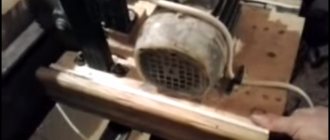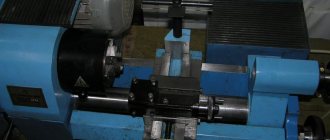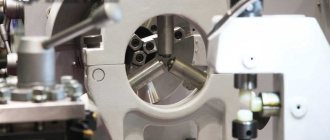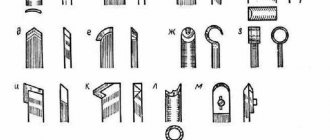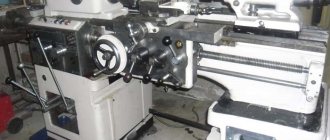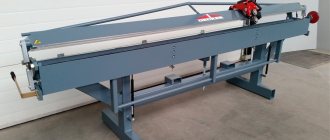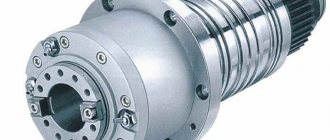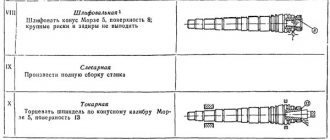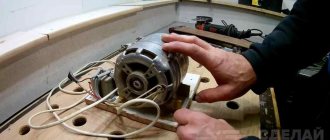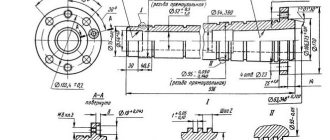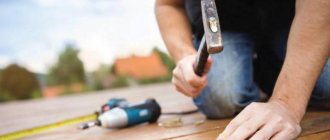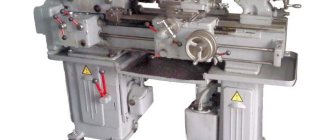Compact tabletop machines allow you to set up a small room for working on individual orders or for opening a small private workshop.
A CNC mini-lathe is a modern piece of equipment equipped with a number of functions that make the work process easier. Thanks to the versatility of the machine, the productivity of production of any scale is significantly increased.
Equipment Features
The mini-machine is designed for processing and manufacturing various small-sized products. Like large production equipment, it can produce a variety of operations using built-in functions:
- Grind parts (conical, cylindrical).
- Trim the ends of the parts.
- Do grinding.
- Drill and ream holes on parts.
- Create external and internal threads.
If you have a machine with a CNC system, the quality of parts and the speed of their production will not differ from products from large production equipment.
Mini-lathes are purchased to equip not only small private workshops, but also for medium-sized manufacturing enterprises and workshops. Also, the mini-mill becomes indispensable for home use - with it, small renovations in the apartment become simple.
Reference! Most often, such equipment can be found in car repair shops and other similar establishments.
Additional equipment of the Azhur-mini machine:
| vendor code | Photo | Name | Note | Samples | Price, rub.) |
SNAILS FOR MANUFACTURING “VOLUTES”, “CHERVONOKS”, “COMMAS” | |||||
| A1-9 | "Snail-B1" | Designed for the production of large-sized “Volyuta” and “Chervonka” elements. The blank used is a profile pipe, circle, square 8, 10, 12, 14, 16 mm. | 11 220 | ||
| A1-11 | "Snail-M1" | Intended for the production of the “Volute” element of an especially small size. The blank used is a profile pipe, circle, square 8, 10, 12 mm. | 7 990 | ||
| A1-12 | "Snail M2" | Designed for the production of the “Chervonka” element of an especially small size. The blank used is a profile pipe, circle, square 8, 10, 12 mm. | 9 330 | ||
| A1-13 | "Snail-BL" | Designed for the manufacture of the element “Volyuta” and “Chervonka” without the “Houndstooth”. A circle, a square of 10, 12 mm is used as a blank. | 10 410 | ||
| A1-23 | "Snail-M3" | Designed for the manufacture of the Volute element without a straight section. The blank used is a profile pipe, circle, square 6, 8, 10, 12, 14, 16 mm. | 8 860 | ||
| A1-25 | “Snail Reverse bending of endings No. 1” | Designed for the production of the “Volute” element with the “Reverse bend” ending. A circle or 12 mm square is used as a blank. | 8 250 | ||
| A1-26 | “Snail Reverse bending of endings No. 2” | Designed for the production of the “Volute” element with the “Reverse bend” ending. A circle or 12 mm square is used as a blank. | 9 860 | ||
| A1-27 | “Snail Reverse bend endings No. 3” | Designed for the manufacture of the “Chervonka” element with the “Reverse bend” ending. A circle or 12 mm square is used as a blank. | 10 120 | ||
| A1-28 | “Snail Reverse bend endings No. 4” | Designed for the manufacture of the “Chervonka” element with the “Reverse bend” ending. A circle or 12 mm square is used as a blank. | 10 230 | ||
| A1-29 | “Snail Reverse bend endings No. 5” | Designed for the production of the “Volute” element with the “Reverse bend” ending. A circle or 12 mm square is used as a blank. | 10 430 | ||
| A1-32 | "Snail-U2" | Designed for the production of “Curls”, “Volutes” and “Chervonoks”. The blank used is a prepared profile pipe 10*10, 15*15 and 20*20 mm, circle, square 8, 10, 12, 14, 16 mm, strip 6*12 mm. | 10 010 | ||
| A1-40 | Snail "B7" | Bending device “Snail B7” for the element “Roman curl” with a diameter of up to 450 mm | 26 150 | ||
DRUMS FOR RING MAKING | |||||
| A1-4 | Device "Drum Ø 125" | A ring Ø 125 mm is intended for the manufacture of an element. The workpiece used is a circle, square 6, 8, 10, 12 mm | 3 630 | ||
| A1-5 | Device "Drum Ø 114" | A ring Ø 114 mm is intended for the manufacture of an element. A circle or square 6, 8, 10, 12 mm is used as a blank. | 2 890 | ||
| A1-6 | Device "Drum Ø 90" | A ring Ø 90 mm is intended for the manufacture of an element. A circle or square 6, 8, 10, 12 mm is used as a blank. | 2 860 | ||
| A1-7 | Device “Drum Ø70” | A ring Ø 70 mm is intended for the manufacture of an element. A circle or square 6, 8, 10, 12 mm is used as a blank. | 2 530 | ||
| A1-8 | Device "Drum Ø 50" | A ring Ø 50 mm is intended for the manufacture of an element. A circle or square 6, 8, 10, 12 mm is used as a blank. | 2 200 | ||
TWISTING DEVICES | |||||
| AM-16 | Torsion bar device | Designed for longitudinal twisting of squares and strips. A square is used as a blank: 10, 12, 14, 16, 20 mm, strip up to 40*10 mm. | 23 400 | ||
| MANUAL EQUIPMENT | |||||
| A1-30 | “Reverse bending of the endings at the Paw” | Designed for making reverse bending of ends. | 10 780 | ||
Video
Main advantages and disadvantages
The main value of a mini-lathe is its dimensions, which allow it to be installed even in small rooms. The machine can also be equipped with additional accessories, which facilitate the performance of complex milling and drilling work.
- The main advantages of the mini-machine are:
- Low power consumption.
- Cost of equipment.
- Increased rigidity in operation, not accompanied by high vibration.
- Equipment dimensions.
- Precision roller bearings ensure high frequency processing.
- The equipment can operate from a standard or adapted electrical network.
- During operation, the machine is quite quiet and does not make any additional noise.
- You can operate the mini-machine at home.
- It is also worth noting the high service life.
- The equipment is quite simple and straightforward to use.
Among the shortcomings, only two can be identified:
- Reduced production speed compared to standard equipment.
- There are also existing limitations in production - only small-sized parts are manufactured.
But these minor disadvantages cannot overcome all the existing advantages of a mini-CNC lathe.
VERTICAL DRILLING AND MILLING MACHINE
The drilling machine already requires the use of two transverse and one vertical slide in its design:
Stated characteristics: Working space: 120 * 100mm Vertical stroke: 30-50mm Drill size: 1-6mm Weight: 2.8kg Size: 160 * 290 * 150mm
A little about the slide. They are made entirely of aluminum and have a relatively complex design:
These fasteners are responsible for pressing the black plastic plate (pictured above):
This is necessary to adjust the smooth running of the slide - on the one hand, they should move freely along the guides, and on the other, they should not play or move due to vibration of the machine during operation. I realized this only towards the end, and the results of processing the workpieces, which you can see below, could have been better. As they say: “Experience is the son of difficult mistakes...” We are assembling the machine...
I realized this only towards the end, and the results of processing the workpieces, which you can see below, could have been better. As they say: “Experience is the son of difficult mistakes...” We are assembling the machine...
Done (I took pictures after use):
Weight:
The kit includes a drill and a milling bit:
The chuck is a collet, so for each drill size you need to change the collet, which is not very convenient:
To raise and lower the drill, a plastic rod is inserted from the side:
The screw fastening is removed from the slides and they become simple guides, without fixation. I was surprised that the lifting rod is plastic, it is a power part and should be made of metal. The drilling depth is about 15mm (in the photo the rod is raised to the highest position, if you lower it by 1mm it will go down into the square hole):
The machine drills wood and soft metals without any problems:
By the way, tightening the cartridge is also not very convenient; you can’t do it by hand; you have to resort to pliers:
If you use a more serious drill (I used one from the Dewalt set), then steel (1-2mm) will do the job:
In addition, you can put a milling drill in the machine:
It can be used to sharpen soft materials (such as aluminum):
In this case, it is more convenient when the drill is stationary and the workpiece being milled is guided by hand. In general, this machine also works:
Video of a vertical drilling and milling machine
to Contents
▲
Characteristics of small tabletop units
When choosing a mini-machine, you need to focus on its technical characteristics, which should be suitable for the chosen area of work and the room in which it will be installed. For example, for home use it is not recommended to buy a machine that is too powerful and heavy.
Basically, lathes are selected according to the following characteristics:
- Power.
- Height of equipment centers.
- Speed capabilities.
- Dimensions of the unit, its weight.
- Maximum speed of movement of the working body.
- Diameter, length of blanks that the equipment can create.
- The size of the hole in the spindle assembly.
The unit is selected individually, based on the requests of the master and his plans for the manufacture of parts.
GRINDING MACHINE
Next comes the grinding machine.
Stated characteristics: Working space: 120 * 100 mm Processed materials: wood, plastic, soft metals Weight: 1.5 kg Dimensions: 290 * 100 * 100 mm One machine can be converted from another quite simply, and each time the assembly time is reduced, because . You already understand what and how to install, what to fit to what and where to tighten. The grinding machine is perhaps the simplest in design:
We screw the sandpaper disc onto the gearbox shaft; on the opposite side of the gearbox shaft there are holes for fixing the shaft:
The complete consumable consists of only two round sandpapers with an adhesive layer:
The assembled machine looks like this:
Works great:
However, naturally, the consumption situation is worrying. I have not seen sandpaper for sale (albeit of a different size) with an adhesive layer on the back side. But there are plenty of sanding wheels with Velcro on sale in any construction market. Therefore, the solution with the flow rate is also found quickly, because In the “bins” from the construction site at the dacha, there were sanding attachments for the grinder, and a bunch of round sandpaper with Velcro (I still didn’t know where to use them):
We tear off the pad made of porous material with a part of Velcro with hooks from the sanding attachment. We cut out circles of the required size from the torn part of the nozzle and sandpaper, then glue part of the nozzle with double-sided tape onto the machine disk:
And we get the opportunity to quickly change erased circles:
We move the platform a little and continue to work on the machine: The grinding machine can also be equipped with a stone for sharpening metal blades (knives, scissors, tools, etc.). There is not a word about this in the instructions, so I had to figure out how to install the whetstone myself. For this purpose, the kit includes the following sleeve:
Installed it like this:
Sharpens normally:
However, as it turned out, I didn’t set it up quite correctly; I found this correct option on the Internet:
And I was wondering why these plastic casings are needed, but, IMHO, of course, my option is more convenient 
Video of the grinding machine in operation
to Contents
▲
Review of popular small models for metal
Several machine tool manufacturers are especially popular on the Russian market, including PROMA, JET, Weiss Machinery.
Among the units produced by JET, the following are popular:
- BD-7.
- BD-3.
- BD-8A.
These Swiss-made models have earned the love of craftsmen for their functionality, compactness and ease of use.
The OPTIMUM company provides universal models of equipment - German equipment has a long service life and potential. Weiss Machinery focuses on simpler equipment, without fancy functionality - thanks to this, the devices are universal and cheap.
Main selection criteria
The machine is a long-term and expensive purchase. For occasional use, a home desktop machine will suffice. For constant work in a garage or workshop, it is better to look at an industrial model.
What to pay attention to when choosing:
- Spindle diameter - determines the maximum diameter of the bar.
- The bed - the more massive and heavier it is, the fewer errors in processing.
- The height above the frame and support - the maximum diameter of future products depends on it.
- The distance between centers is important if you plan to process long shafts.
- Possibility to use additional equipment that increases functionality.
- Automatic caliper feed.
- The weight of the unit is enough for a workshop to be up to 80 kg.
- Manufacturer - if possible, it is better to buy Russian models in order to avoid problems with finding spare parts in the future.
Reference! You need to focus on the above parameters based on your work needs.
